
A bumblebee is any of over 250 species in the genus Bombus, part of Apidae, one of the bee families. This genus is the only extant group in the tribe Bombini, though a few extinct related genera are known from fossils. They are found primarily in higher altitudes or latitudes in the Northern Hemisphere, although they are also found in South America, where a few lowland tropical species have been identified. European bumblebees have also been introduced to New Zealand and Tasmania. Female bumblebees can sting repeatedly, but generally ignore humans and other animals.

Bombus lapidarius is a species of bumblebee in the subgenus Melanobombus. Commonly known as the red-tailed bumblebee, B. lapidarius can be found throughout much of Central Europe. Known for its distinctive black and red body, this social bee is important in pollination.
Bombus breviceps is a species of bumblebee.

Bombus pensylvanicus, the American bumblebee, is a threatened species of bumblebee native to North America. It occurs in eastern Canada, throughout much of the Eastern United States, and much of Mexico.
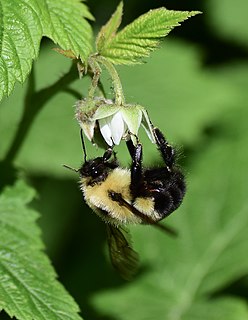
The two-spotted bumble bee is a species of social bumble bee found in the eastern half of the United States and the adjacent south-eastern part of Canada. In older literature this bee is often referred to as Bremus bimaculatus, Bremus being a synonym for Bombus. The bee's common name comes from the two yellow spots on its abdomen. Unlike many of the other species of bee in the genus Bombus,B. bimaculatus is not on the decline, but instead is very stable. They are abundant pollinators that forage at a variety of plants.

Bombus vosnesenskii, the yellow-faced bumblebee, is a species of bumblebee native to the west coast of North America, where it is distributed from British Columbia to Baja California. It is the most abundant species of bee in this range, and can be found in both urban and agricultural areas. Additionally, B. vosnesenskii is utilized as an important pollinator in commercial agriculture, especially for greenhouse tomatoes. Though the species is not currently experiencing population decline, urbanization has affected its nesting densities, and early emergence of the B. vosnesenskii has been implicated in the increasing lack of bee diversity on the West coast.

Bombus occidentalis, the western bumblebee, is one of around 30 bumblebee species present in the western United States and western Canada. A recent review of all of its close relatives worldwide appears to have confirmed its status as a separate species.
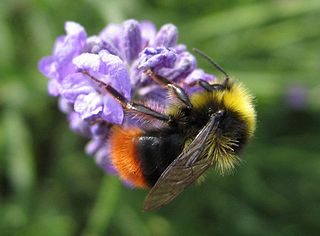
Pyrobombus is a subgenus of bumblebees, with its centres of diversity in Central Asia and north-western North America. Nearly a fifth of all Bombus species fall within Pyrobombus and its member species vary considerably in size, appearance and behaviour. it covers 43 species of bees and is the largest subgenus of bumblebees, covering almost 50% of the North American fauna. They are seen to be declined by 6%, which may be an undervalued statistic, although not as high as other groups of bees. Pyrobombus bees also face issues such as climate change, loss of habitat, urbanization, and industrial agriculture. This subgenus of bees can pollinate that helps plants fertilise and grow fruit that is essential to the biodiversity and life of the environment. Commonly, Pyrobombus bees are used for beekeeping as they are pollinators. They can be for wax, honey, venom, combs, and such which may be collected for commercial use. This subgenus may vary in their characteristics such as body size, wingspan, and tongue length for individual species, but like all bees, they possess wings, a head, thorax, and abdomen.

Bombus fervidus, the golden northern bumble bee or yellow bumblebee, is a species of bumblebee native to North America. It has a yellow-colored abdomen and thorax. Its range includes the North American continent, excluding much of the southern United States, Alaska, and the northern parts of Canada. It is common in cities and farmland, with populations concentrated in the Northeastern part of the United States. It is similar in color and range to the American bumblebee. It has complex behavioral traits, which includes a coordinated nest defense to ward off predators. B. fervidus is an important pollinator, so recent population decline is a particular concern.

Bombus ruderatus, the large garden bumblebee or ruderal bumblebee, is a species of long-tongued bumblebee found in Europe and in some parts of northern Africa. This species is the largest bumblebee in Britain and it uses its long face and tongue to pollinate hard-to-reach tubed flowers. Bumblebees are key pollinators in many agricultural ecosystems, which has led to B. ruderatus and other bumblebees being commercially bred and introduced into non-native countries, specifically New Zealand and Chile. Since its introduction in Chile, B. ruderatus has spread into Argentina as well. Population numbers have been declining and it has been placed on the Biodiversity Action Plan to help counteract these declines.

Bombus dahlbomii is a species of bumblebee endemic to southern South American temperate forests. B. dahlbomii is one of the largest bee species in the world, with matured queens growing up to 40 mm (1.6 in) long. Because of its size and furry appearance, the species has been described as "flying mice" colloquially, and "a monstrous fluffy ginger beast" by British ecologist David Goulson.
Bombus bifarius, the two-form bumblebee, is a species of eusocial bumblebee of the subgenus Pyrobombus. B. bifarius inhabits mountainous regions of western North America, primarily the states of Colorado and Utah. Its common name refers to a historical artifact, in that it was believed that this species had a color polymorphism, with a red-tailed nominate form and a black-tailed nearcticus form, present in the species. This polymorphism has recently been shown to belong instead to a cryptic sister species, Bombus vancouverensis, that occupies almost the entirety of the range of what was formerly classified as bifarius; true bifarius only has a red form, so it is not "two-formed" at all.

Bombus morio is one of the few bumblebee species found in South America. These bees reside mainly in the forests of Brazil, nesting on the surface of the ground. They are one of the biggest species of bumblebee and are important pollinators. They are one of the few species of bees that exhibit buzz pollination to collect pollen from the flowers.

Bombus crotchii, commonly called Crotch's bumblebee, is a species of bumblebee named after the entomologist George Robert Crotch. It is classified as endangered due to the impacts of pesticides, climate change, and human development.

Bombus griseocollis is a species of bumblebee known commonly as the brown-belted bumblebee. It is native to much of the United States except for the Southwest, and to the southernmost regions of several of the provinces of Canada.
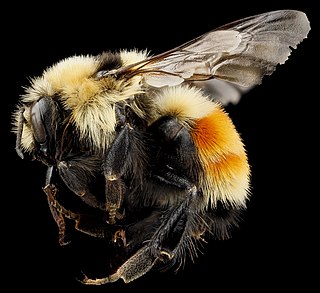
Bombus huntii is a species of bumblebee. It is native to western North America, where it occurs in western Canada and the United States as far east as Manitoba and Minnesota, and in Mexico as far south as the Trans-Mexican Volcanic Belt. It is known commonly as the Hunt bumblebee or Hunt's bumblebee.
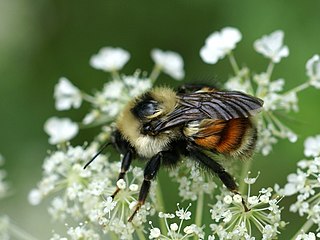
Bombus rufocinctus is a species of bumblebee known by the common name red-belted bumblebee. It is native to North America where it has a wide distribution across Canada and the western, midwestern, and northeastern United States. It may occur in Mexico.
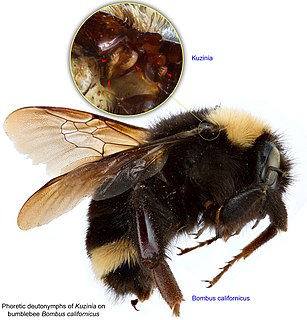
Bombus californicus, the California bumble bee, is a species of bumble bee in the family Apidae. Bombus californicus is in genus Bombus and subgenus Thoracobombus. It is found in Central America and North America. Bombus californicus is classified as Vulnerable by the IUCN.
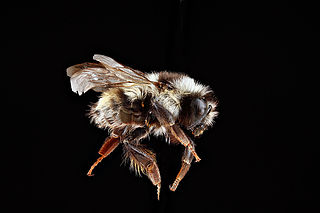
Bombus vancouverensis is a common species of eusocial bumblebee of the subgenus Pyrobombus. B. vancouverensis inhabits mountainous regions of western North America, where it has long been considered as a synonym of Bombus bifarius, and essentially all of the literature on bifarius refers instead to vancouverensis. B. vancouverensis has been identified as one of the two species of bumblebee observed to use pheromones in kin recognition. The other is the frigid bumblebee, Bombus frigidus.


















